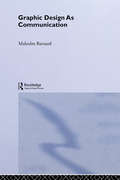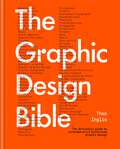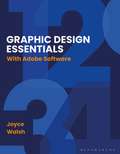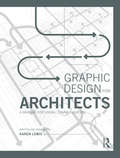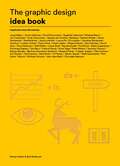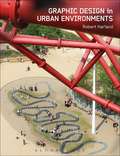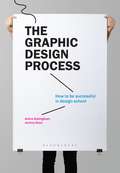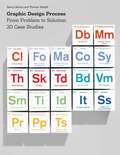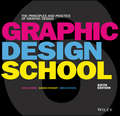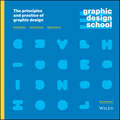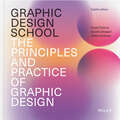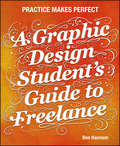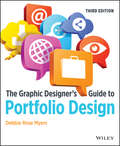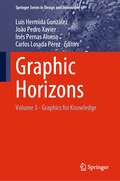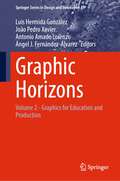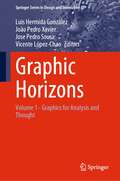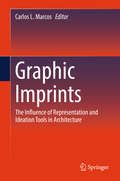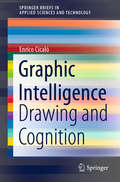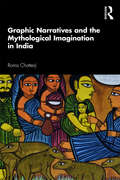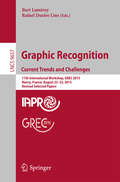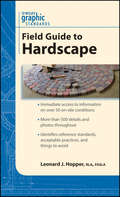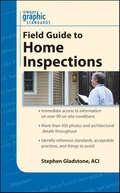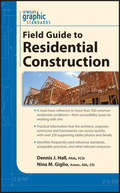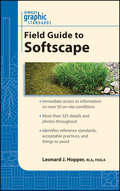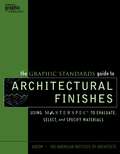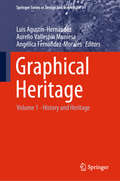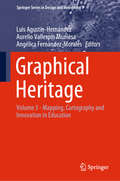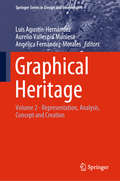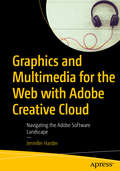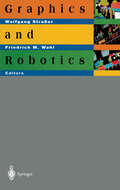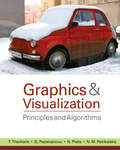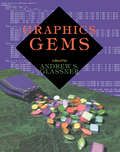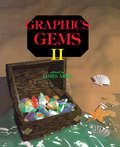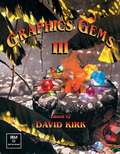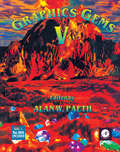- Table View
- List View
Graphic Design as Communication
by Malcolm BarnardWhat is the point of graphic design? Is it advertising or is it art? What purpose does it serve in our society and culture? Malcolm Barnard explores how meaning and identity are at the core of every graphic design project and argues that the role and function of graphic design is, and always has been, communication.Drawing on a range of theoretical approaches including those of Derrida, Saussure, Foucault, and Barthes, and taking examples from advertising, magazines, illustration, website design, comics, greetings cards and packaging, Graphic Design as Communication looks at how graphic design contributes to the formation of social and cultural identities. Malcolm Barnard discusses the ways in which racial/ethnic groups, age groups and gender groups are represented in graphic design, as well as how images and texts communicate with different cultural groups. He also explores how graphic design relates to both European and American modernism, and its relevance to postmodernism and globalisation in the twenty-first century and asks why, when graphic design is such an integral part of our society and culture, it is not acknowledged and understood in the same way that art is.
Graphic Design as Communication
by Malcolm BarnardWhat is the point of graphic design? Is it advertising or is it art? What purpose does it serve in our society and culture? Malcolm Barnard explores how meaning and identity are at the core of every graphic design project and argues that the role and function of graphic design is, and always has been, communication.Drawing on a range of theoretical approaches including those of Derrida, Saussure, Foucault, and Barthes, and taking examples from advertising, magazines, illustration, website design, comics, greetings cards and packaging, Graphic Design as Communication looks at how graphic design contributes to the formation of social and cultural identities. Malcolm Barnard discusses the ways in which racial/ethnic groups, age groups and gender groups are represented in graphic design, as well as how images and texts communicate with different cultural groups. He also explores how graphic design relates to both European and American modernism, and its relevance to postmodernism and globalisation in the twenty-first century and asks why, when graphic design is such an integral part of our society and culture, it is not acknowledged and understood in the same way that art is.
The Graphic Design Bible
by Theo InglisDiscover the history and theory of graphic design from the past 150 years, and how that comes to bear on contemporary design. Designer, writer and lecturer Theo Inglis takes readers through the core building blocks of graphic design such as composition, colour, medium and typography, and explores how each has been utilized and revolutionized by designers through history, and up to the present day.This book will expand your knowledge of the world of design and provide you with practical take-aways to inform your own creative practice.
Graphic Design Essentials: With Adobe Software
by Joyce WalshLearning by doing is the best way to get to grips with new ideas, and graphic design is no different. Weaving together creative strategies and design principles with step-by-step Adobe software guidance, this unique book helps you to immediately put into practice the concepts as you're learning them so they become second nature.Covering all the introductory topics a designer needs to know – from working with colour and layout, to editing images and designing apps – this fully updated edition of the hugely popular Graphic Design Essentials includes plenty of hands-on instruction and real-life examples to give you a thorough grounding in the fundamentals.This new edition includes:- Coverage of Adobe Illustrator, Photoshop and InDesign - Examples of designs from the UK, US, Canada, Europe, Hong Kong, China, the Middle East and Australia- Smaller supporting activities alongside major project exercises- New design formats, including apps and infographics- Downloadable resources to use within the software instruction
Graphic Design Essentials: With Adobe Software
by Joyce WalshLearning by doing is the best way to get to grips with new ideas, and graphic design is no different. Weaving together creative strategies and design principles with step-by-step Adobe software guidance, this unique book helps you to immediately put into practice the concepts as you're learning them so they become second nature.Covering all the introductory topics a designer needs to know – from working with colour and layout, to editing images and designing apps – this fully updated edition of the hugely popular Graphic Design Essentials includes plenty of hands-on instruction and real-life examples to give you a thorough grounding in the fundamentals.This new edition includes:- Coverage of Adobe Illustrator, Photoshop and InDesign - Examples of designs from the UK, US, Canada, Europe, Hong Kong, China, the Middle East and Australia- Smaller supporting activities alongside major project exercises- New design formats, including apps and infographics- Downloadable resources to use within the software instruction
Graphic Design for Architects: A Manual for Visual Communication
by Karen LewisGraphic Design for Architects is a handbook of techniques, explanations and examples of graphic design most relevant to architects. The book covers a variety of scales of graphic design, everything from portfolio design and competition boards, to signage and building super-graphics – to address every phase of architectural production. This book combines and expands on information typically found in graphic design, information design, and architectural graphics books. As architectural communication increases to include more territory and components of a project, it is important for designers to be knowledgeable about the various ways in which to communicate visually. For instance, signage should be designed as part of the process – not something added at the end of a project; and the portfolio is a manifestation of how the designer works, not just an application to sell a design sensibility. In thinking about architecture as a systematic and visual project, the graphic design techniques outlined in this book will help architects process, organize and structure their work through the lens of visual communication. Each chapter is titled and organized by common architectural modes of communication and production. The chapters speak to architects by directly addressing projects and topics relevant to their work, while the information inside each chapter presents graphic design methods to achieve the architects’ work. In this way, readers don’t have to search through graphic design books to figure out what’s relevant to them – this book provides a complete reference of graphic techniques and methods most useful to architects in getting their work done.
Graphic Design for Architects: A Manual for Visual Communication
by Karen LewisGraphic Design for Architects is a handbook of techniques, explanations and examples of graphic design most relevant to architects. The book covers a variety of scales of graphic design, everything from portfolio design and competition boards, to signage and building super-graphics – to address every phase of architectural production. This book combines and expands on information typically found in graphic design, information design, and architectural graphics books. As architectural communication increases to include more territory and components of a project, it is important for designers to be knowledgeable about the various ways in which to communicate visually. For instance, signage should be designed as part of the process – not something added at the end of a project; and the portfolio is a manifestation of how the designer works, not just an application to sell a design sensibility. In thinking about architecture as a systematic and visual project, the graphic design techniques outlined in this book will help architects process, organize and structure their work through the lens of visual communication. Each chapter is titled and organized by common architectural modes of communication and production. The chapters speak to architects by directly addressing projects and topics relevant to their work, while the information inside each chapter presents graphic design methods to achieve the architects’ work. In this way, readers don’t have to search through graphic design books to figure out what’s relevant to them – this book provides a complete reference of graphic techniques and methods most useful to architects in getting their work done.
The Graphic Design Idea Book: Inspiration from 50 Masters
by Gail Anderson Gaile Anderson Steven HellerThis book serves as an introduction to the key elements of good design.Broken into sections covering the fundamental elements of design, key works by acclaimed designers serve to illustrate technical points and encourage readers to try out new ideas. Themes covered include narrative, colour, illusion, ornament, simplicity, and wit and humour.The result is an instantly accessible and easy to understand guide to graphic design using professional techniques.
Graphic Design in Urban Environments
by Robert HarlandGraphic Design in Urban Environments introduces the idea of a category of designed graphic objects that significantly contribute to the functioning of urban systems. These elements, smaller than buildings, are generally understood by urban designers to comprise such phenomena as sculpture, clock towers, banners, signs, large screens, the portrayal of images on buildings through "smart screens,†? and other examples of what urban designers call "urban objects.†?The graphic object as it is defined here also refers to a range of familiar things invariably named in the literature as maps, street numbers, route signs, bus placards, signs, architectural communication, commercial vernacular, outdoor publicity, lettering, banners, screens, traffic and direction signs and street furniture. One can also add markings of a sports pitch, lighting, bollards, even red carpets or well dressings.By looking at the environment, and design and deconstructing form and context relationships, the defining properties and configurational patterns that make up graphic objects are shown in this book to link the smallest graphic detail (e.g. the number 16) to larger symbolic statements (e.g. the Empire State Building). From a professional design practice perspective, a cross section through type, typographic, graphic and urban design will provide a framework for considering the design transition between alphabets, writing systems, images (in the broadest sense) and environments.
Graphic Design in Urban Environments
by Robert HarlandGraphic Design in Urban Environments introduces the idea of a category of designed graphic objects that significantly contribute to the functioning of urban systems. These elements, smaller than buildings, are generally understood by urban designers to comprise such phenomena as sculpture, clock towers, banners, signs, large screens, the portrayal of images on buildings through “smart screens,” and other examples of what urban designers call “urban objects.”The graphic object as it is defined here also refers to a range of familiar things invariably named in the literature as maps, street numbers, route signs, bus placards, signs, architectural communication, commercial vernacular, outdoor publicity, lettering, banners, screens, traffic and direction signs and street furniture. One can also add markings of a sports pitch, lighting, bollards, even red carpets or well dressings.By looking at the environment, and design and deconstructing form and context relationships, the defining properties and configurational patterns that make up graphic objects are shown in this book to link the smallest graphic detail (e.g. the number 16) to larger symbolic statements (e.g. the Empire State Building). From a professional design practice perspective, a cross section through type, typographic, graphic and urban design will provide a framework for considering the design transition between alphabets, writing systems, images (in the broadest sense) and environments.
The Graphic Design Process: How to be successful in design school
by Anitra Nottingham Jeremy StoutOne of the main challenges students face upon entering design school is little knowledge of the field, its terminology and best practices. Unsurprisingly, most new students have never fully developed a concept or visual idea, been in a critique, or have been asked to explain their work to others. This book demystifies what design school is really like and explains what will be experienced at each stage, with particular focus on practical advice on topics like responding to design briefs and developing ideas, building up confidence and understanding what is expected. · Student work is critiqued to show how projects are really assessed· Profiles highlight how professional designers themselves address client briefs· Tips for real-life problems are outlined, like getting stuck and dealing with critical feedback Written by experienced instructors, this is the perfect guide for those starting their design education.
The Graphic Design Process: How to be successful in design school
by Anitra Nottingham Jeremy StoutOne of the main challenges students face upon entering design school is little knowledge of the field, its terminology and best practices. Unsurprisingly, most new students have never fully developed a concept or visual idea, been in a critique, or have been asked to explain their work to others. This book demystifies what design school is really like and explains what will be experienced at each stage, with particular focus on practical advice on topics like responding to design briefs and developing ideas, building up confidence and understanding what is expected. · Student work is critiqued to show how projects are really assessed· Profiles highlight how professional designers themselves address client briefs· Tips for real-life problems are outlined, like getting stuck and dealing with critical feedback Written by experienced instructors, this is the perfect guide for those starting their design education.
Graphic Design Process: From Problem to Solution
by Nancy Skolos Thomas WedellThe process of creating graphic design cannot be easily defined: each designer has their own way of seeing the world and approaching their work. Graphic Design Process features a series of in-depth case studies exploring a range of both universal and unique design methods. Chapters investigate typical creative strategies – Research, Inspiration, Drawing, Narrative, Abstraction, Development and Collaboration – examining the work of 23 graphic designers from around the world. Work featured includes projects by Philippe Apeloig, Michael Bierut, Ed Fella, James Goggin, Anette Lenz, Johnson Banks, Me Company, Graphic Thought Facility, Ahn Sang-Soo and Ralph Schraivogel. This book is aimed at students and educators, as well as practising designers interested in the working methodologies of their peers.
Graphic Design School: The Principles and Practice of Graphic Design
by David Dabner Sandra Stewart Abbie VickressThe essential introduction to graphic design for the digital era Graphic Design School provides a comprehensive introduction to visual design for modern media. From the fundamentals of design to advanced techniques and problem solving, this book is packed with practical advice and tutorials for a broad range of applications in any media. This updated sixth edition features a wealth of new guidance that reflects the evolution of the field, including extensive discussion of digital design and resourcing. New discussion tackles User Experience and User Interface Design, plus the latest tools, requirements, and resources for designing for the web, mobile apps, social media, and more. Updated assignments reflect the latest graphic design processes and guide students through the transition from simple solutions to starter portfolio pieces, while full-color illustrations, case studies, and designer biographies bring real-world perspective to this complex, multi-faceted skill. As media continues to evolve, graphic designers must possess a core set of competencies that translate across all applications. This book teaches the critical concepts and essential skills that build the framework for successful, innovative design. Master the principles, elements, and tools of design Delve into typography, color, and layout for print and screen Understand coding requirements and information architecture Design for apps, social media, mobile devices, and more Graphic design has never been a static field, and the continual honing of skills and techniques is an essential part of the job. Innovation comes from change, and today's design landscape is evolving at an ever-increasing pace—expanding diversity in media, audience, topic, technique, tools, and more offer unprecedented opportunity to make your mark. Graphic Design School equips you with a rock-solid foundation to support whatever your talent builds.
Graphic Design School: The Principles and Practice of Graphic Design
by David Dabner Sandra Stewart Abbie VickressThe essential introduction to graphic design for the digital era Graphic Design School provides a comprehensive introduction to visual design for modern media. From the fundamentals of design to advanced techniques and problem solving, this book is packed with practical advice and tutorials for a broad range of applications in any media. This updated sixth edition features a wealth of new guidance that reflects the evolution of the field, including extensive discussion of digital design and resourcing. New discussion tackles User Experience and User Interface Design, plus the latest tools, requirements, and resources for designing for the web, mobile apps, social media, and more. Updated assignments reflect the latest graphic design processes and guide students through the transition from simple solutions to starter portfolio pieces, while full-color illustrations, case studies, and designer biographies bring real-world perspective to this complex, multi-faceted skill. As media continues to evolve, graphic designers must possess a core set of competencies that translate across all applications. This book teaches the critical concepts and essential skills that build the framework for successful, innovative design. Master the principles, elements, and tools of design Delve into typography, color, and layout for print and screen Understand coding requirements and information architecture Design for apps, social media, mobile devices, and more Graphic design has never been a static field, and the continual honing of skills and techniques is an essential part of the job. Innovation comes from change, and today's design landscape is evolving at an ever-increasing pace—expanding diversity in media, audience, topic, technique, tools, and more offer unprecedented opportunity to make your mark. Graphic Design School equips you with a rock-solid foundation to support whatever your talent builds.
Graphic Design School: The Principles and Practice of Graphic Design
by David Dabner Sandra Stewart Abbie VickressFrom understanding graphic design fundamentals, to developing original concepts, to creating finished designs-Graphic Design School develops design students' core competencies and provides practical advice and tips for how these fundamentals translate into new and evolving media. This Seventh Edition offers all new examples from web, app, social media, magazines, websites and books, presenting a comprehensive overview of the visual communications profession. This updated edition includes guidance and media examples using the latest in grahpic design software, and traditional printing techniques such as risograph and screen printing are revisited. Pedagogical tools throughout the text focus on the growth of interdisciplinary learning and collaborations between design specialists, as well as highlights on key players in the past and present of graphic design. Topics covered include: color, typographic rules and typefaces, coding requirements, information architecture, file organization, web design and layout, mobile device composition, app design, CMS, designing for social media, and SEO. Graphic Design School, 7th Edition includes full-color illustrations throughout, as well as case studies, designer biographies, and student assignments for testing skills and concepts.
Graphic Design School: The Principles and Practice of Graphic Design
by David Dabner Sandra Stewart Abbie VickressRevised and updated edition of the leading graphic design textbook, with new examples, the latest tools, and many new illustrations. From understanding graphic design fundamentals, to developing original concepts, to creating finished designs—Graphic Design School develops design students' core competencies and provides practical advice and tips for how these fundamentals translate into new and evolving media. This Eighth Edition is updated with many new images and examples including apps, social media, magazines, websites, and books, presenting a comprehensive overview of the visual communications profession. Other updates in this edition include refreshed reading lists with more diverse practitioners, updated guidance, and media examples using the latest in graphic design software. Graphic Design School, 8th Edition, covers the fundamentals of design including: Color, typographic rules and typefaces, web design and layout, and app or social media design Information architecture, file organization, and content management The importance of coding requirements and SEO Case studies, designer biographies, and student assignments for testing skills and concepts Revisits traditional printing techniques such as risograph and screen printing Graphic Design School, 8th Edition includes full-color illustrations throughout, with pedagogical tools that focus on the growth of interdisciplinary learning and collaborations between design specialists, as well as highlights on key players in the past and present of graphic design.
Graphic Design School: The Principles and Practice of Graphic Design
by Sandra Stewart David Dabner Abbie VickressFrom understanding graphic design fundamentals, to developing original concepts, to creating finished designs—Graphic Design School develops design students' core competencies and provides practical advice and tips for how these fundamentals translate into new and evolving media. This Seventh Edition offers all new examples from web, app, social media, magazines, websites and books, presenting a comprehensive overview of the visual communications profession. This updated edition includes guidance and media examples using the latest in grahpic design software, and traditional printing techniques such as risograph and screen printing are revisited. Pedagogical tools throughout the text focus on the growth of interdisciplinary learning and collaborations between design specialists, as well as highlights on key players in the past and present of graphic design. Topics covered include: color, typographic rules and typefaces, coding requirements, information architecture, file organization, web design and layout, mobile device composition, app design, CMS, designing for social media, and SEO. Graphic Design School, 7th Edition includes full-color illustrations throughout, as well as case studies, designer biographies, and student assignments for testing skills and concepts.
A Graphic Design Student's Guide to Freelance: Practice Makes Perfect
by Ben HannamA complete guide to freelance graphic design—created specifically for design students Why wait until you graduate? Freelancing is a great way to jumpstart your career in graphic design. It lets you apply what you've been learning in school, close the gaps in your education with real-world experience, enhance your portfolio—and make a little money at the same time. A Graphic Design Student's Guide to Freelance: Practice Makes Perfect covers everything you need to know to begin successfully freelancing as a designer, including how to set up your business, deal with legal and financial issues, find clients, and work with them effectively. This full-color guide is divided into sections that correspond to your particular skill level as a student—beginner, intermediate, or advanced. These sections give you specific tasks and goals to help your freelance design work go smoothly as you progress from your very first professional job to gain experience with a range of projects and clients and prepare to move into a full-time graphic design career once you complete your studies. Complete with sample forms available online (invoices, a proof approval form, job jacket, and more) and 175 color images, including samples of paid work created by students, A Graphic Design Student's Guide to Freelance: Practice Makes Perfect will help you navigate the world of freelance design with confidence. Inside this book, you will learn to: Write a business plan Purchase key equipment Set rates and draw up contracts Find and manage clients Create and show concepts Market your company Expand your business Develop your portfolio And more
A Graphic Design Student's Guide to Freelance: Practice Makes Perfect
by Ben HannamA complete guide to freelance graphic design—created specifically for design students Why wait until you graduate? Freelancing is a great way to jumpstart your career in graphic design. It lets you apply what you've been learning in school, close the gaps in your education with real-world experience, enhance your portfolio—and make a little money at the same time. A Graphic Design Student's Guide to Freelance: Practice Makes Perfect covers everything you need to know to begin successfully freelancing as a designer, including how to set up your business, deal with legal and financial issues, find clients, and work with them effectively. This full-color guide is divided into sections that correspond to your particular skill level as a student—beginner, intermediate, or advanced. These sections give you specific tasks and goals to help your freelance design work go smoothly as you progress from your very first professional job to gain experience with a range of projects and clients and prepare to move into a full-time graphic design career once you complete your studies. Complete with sample forms available online (invoices, a proof approval form, job jacket, and more) and 175 color images, including samples of paid work created by students, A Graphic Design Student's Guide to Freelance: Practice Makes Perfect will help you navigate the world of freelance design with confidence. Inside this book, you will learn to: Write a business plan Purchase key equipment Set rates and draw up contracts Find and manage clients Create and show concepts Market your company Expand your business Develop your portfolio And more
The Graphic Designer's Guide to Portfolio Design
by Debbie Rose MyersLanding a job in graphic design or multimedia starts with the creation of a portfolio that showcases a student's best work. With sample portfolios, interviews with leaders in graphic design and advertising industries, and step-by-step instruction for creating professional print and digital portfolios, this book helps students successfully transition from design student to design professional. Now fully updated, it is the only guide to creating job-winning print-based and digital portfolios specifically for graphic designers.
The Graphic Designer's Guide to Portfolio Design
by Debbie Rose MyersLanding a job in graphic design or multimedia starts with the creation of a portfolio that showcases a student's best work. With sample portfolios, interviews with leaders in graphic design and advertising industries, and step-by-step instruction for creating professional print and digital portfolios, this book helps students successfully transition from design student to design professional. Now fully updated, it is the only guide to creating job-winning print-based and digital portfolios specifically for graphic designers.
Graphic Horizons: Volume 3 - Graphics for Knowledge (Springer Series in Design and Innovation #44)
by Luis Hermida González João Pedro Xavier Inés Pernas Alonso Carlos Losada PérezThis book reports on several advances in architectural graphics, with a special emphasis on education, research and heritage. It gathers a selection of contributions to the 20th International Congress of Architectural Graphic Expression, EGA 2024, held on May 27-29, 2024, in Porto, Portugal, with the motto: "Graphic Horizons". This is the third volume of a 3-volume set.
Graphic Horizons: Volume 2 - Graphics for Education and Production (Springer Series in Design and Innovation #43)
by Luis Hermida González João Pedro Xavier Antonio Amado Lorenzo Ángel J. Fernández-ÁlvarezThis book reports on several advances in architectural graphics, with a special emphasis on education, training, and architectural production. It gathers a selection of contributions to the 20th International Congress of Architectural Graphic Expression, EGA 2024, held on May 27-29, 2024, in Porto, Portugal, with the motto: "Graphic Horizons". This is the second of a 3-volume set.
Graphic Horizons: Volume 1 - Graphics for Analysis and Thought (Springer Series in Design and Innovation #42)
by Luis Hermida González João Pedro Xavier Jose Pedro Sousa Vicente López-ChaoThis book reports on several advances in architectural graphics, with a special emphasis on education, training, and research. It gathers a selection of contributions to the 20th International Congress of Architectural Graphic Expression, EGA 2024, held on May 27-29, 2024, in Porto, Portugal, with the motto: "Graphic Horizons". This is the first of a 3-volume set.
Graphic Imprints: The Influence of Representation and Ideation Tools in Architecture
by Carlos L. MarcosThis is the Proceedings of the International Congress of Graphic Design in Architecture, EGA 2018, held in Alicante, Spain, May 30-June 1, 2018. About 200 professionals and researchers from 18 different countries attended the Congress. This book will be of interest to researchers in the field of architecture and Engineering. Topics discussed are Innovations in Architecture, graphic design and architecture, history and heritage among others.
Graphic Intelligence: Drawing and Cognition (SpringerBriefs in Applied Sciences and Technology)
by Enrico CicalòThis book demonstrates and discusses the hypothesis that, within the theory of multiple intelligences, graphic intelligence can be isolated and defined as the ability to use graphic skills to solve problems and create products through the integration and coordination of eye, mind and hand, that is, visual perception, thought and graphic representation. Since it is essential to the development of thought in various disciplinary and professional fields, graphic intelligence is considered an intellectual skill that needs to be taught not only in specialist training, but also in general training and at all levels of education, from pre- and primary school to higher education. The book discusses the role of graphic intelligence within the design, scientific, artistic, education and communication disciplines, highlighting how graphic skills are fundamental to enhancing cognitive and imaginative abilities in all areas of training and professional knowledge.
Graphic Narratives and the Mythological Imagination in India
by Roma ChatterjiThis book explores graphic narratives and comics in India and demonstrates how these forms serve as sites on which myths are enacted and recast. It uses the case studies of a comics version of the Mahabharata War, a folk artist’s rendition of a comic book story, and a commercial project to re-imagine two of India’s most famous epics – the Ramayana and the Mahabharata – as science fiction and superhero tales. It discusses comic books and self-published graphic novels; bardic performance aided with painted scrolls and commercial superhero comics; myths, folklore, and science fiction; and different pictorial styles and genres of graphic narration and storytelling. It also examines the actual process of the creation of comics besides discussions with artists on the tools and location of the comics medium as well as the method and impact of translation and crossover genres in such narratives. With its clear, lucid style and rich illustrations, the book will be useful to scholars and researchers of sociology, anthropology, visual culture and media, and South Asian studies, as well as those working on art history, religion, popular culture, graphic novels, art and design, folk culture, literature, and performing arts.
Graphic Narratives and the Mythological Imagination in India
by Roma ChatterjiThis book explores graphic narratives and comics in India and demonstrates how these forms serve as sites on which myths are enacted and recast. It uses the case studies of a comics version of the Mahabharata War, a folk artist’s rendition of a comic book story, and a commercial project to re-imagine two of India’s most famous epics – the Ramayana and the Mahabharata – as science fiction and superhero tales. It discusses comic books and self-published graphic novels; bardic performance aided with painted scrolls and commercial superhero comics; myths, folklore, and science fiction; and different pictorial styles and genres of graphic narration and storytelling. It also examines the actual process of the creation of comics besides discussions with artists on the tools and location of the comics medium as well as the method and impact of translation and crossover genres in such narratives. With its clear, lucid style and rich illustrations, the book will be useful to scholars and researchers of sociology, anthropology, visual culture and media, and South Asian studies, as well as those working on art history, religion, popular culture, graphic novels, art and design, folk culture, literature, and performing arts.
Graphic Recognition. Current Trends and Challenges: 11th International Workshop, GREC 2015, Nancy, France, August 22–23, 2015, Revised Selected Papers (Lecture Notes in Computer Science #9657)
by Bart Lamiroy Rafael Dueire LinsThis book constitutes the thoroughly refereed post-conference proceedings of the 11th International Workshop on Graphics Recognition, GREC 2015, held in Nancy, France, in August 2015. The 10 revised full papers presented were carefully reviewed and selected from 19 initial submissions. They contain both classical and emerging topics of Graphics Recognition, namely symbol spotting; recognition in context; perceptual based approaches and grouping; low level processing; off-line to on-line and interactive systems; structure based approaches; performance evaluation and ground truthing; content based retrieval.
Graphic Standards Field Guide to Hardscape
by Leonard J. HopperQuick, reliable answers to your most common on-site questions When you're in the field, you never know what you'll come across. The Graphic Standards Field Guide to Hardscape gives you fast access to the practical information you need when you're on-site and under pressure. Presented in a highly visual and easily portable format, the Field Guide is organized to follow a logical project sequence from site evaluation of existing conditions through construction maintenance. Covering everything from assessing existing conditions, site work, bases and paving, site improvements, and materials, this handy companion conveys the most common answers that landscape architects need in the real world when visiting a construction site, and meeting with architects and engineers or clients and contractors. The Field Guide to Hardscape extends the familiar Landscape Architectural Graphic Standards beyond the office or studio with: Quick access to essential information when away from the studio Things to look for when assessing existing conditions during preliminary design site visits or pre-construction meetings Graphic Standards—quality details accompanied by real-world photographs of best construction practices and techniques Illustrations that help you troubleshoot problems, along with on-the-spot solutions A list of common construction mistakes and problems to avoid Compact format that's easy to reference and carry along The Graphic Standards Field Guide to Hardscape is the ideal companion for the on-the-go landscape architect, design professional, inspector, facilities manager or anyone that is involved with site construction.
Graphic Standards Field Guide to Hardscape (Coursesmart Ser.)
by Leonard J. Hopper Rla FaslaQuick, reliable answers to your most common on-site questions When you're in the field, you never know what you'll come across. The Graphic Standards Field Guide to Hardscape gives you fast access to the practical information you need when you're on-site and under pressure. Presented in a highly visual and easily portable format, the Field Guide is organized to follow a logical project sequence from site evaluation of existing conditions through construction maintenance. Covering everything from assessing existing conditions, site work, bases and paving, site improvements, and materials, this handy companion conveys the most common answers that landscape architects need in the real world when visiting a construction site, and meeting with architects and engineers or clients and contractors. The Field Guide to Hardscape extends the familiar Landscape Architectural Graphic Standards beyond the office or studio with: Quick access to essential information when away from the studio Things to look for when assessing existing conditions during preliminary design site visits or pre-construction meetings Graphic Standards—quality details accompanied by real-world photographs of best construction practices and techniques Illustrations that help you troubleshoot problems, along with on-the-spot solutions A list of common construction mistakes and problems to avoid Compact format that's easy to reference and carry along The Graphic Standards Field Guide to Hardscape is the ideal companion for the on-the-go landscape architect, design professional, inspector, facilities manager or anyone that is involved with site construction.
Graphic Standards Field Guide to Home Inspections (Graphic Standards Field Guide series #4)
by Stephen GladstoneQuick, reliable answers to your most common on-site questions When you're in the field, you never know what you'll come across. The Wiley Graphic Standards Field Guide to Home Inspections gives you fast access to the information you need when you're on-site and under pressure. Presented in a highly visual and easily portable format, the Graphic Standards Field Guide to Home Inspections is organized according to CSI's Masterformat standards of practice. It covers everything from inspection preparation to on-site safety, conveying the most common answers with practical instruction about home inspections that the professional inspector, architect, engineer, or contractor needs to access quickly out in the field to evaluate an existing residential property. The Field Guide to Home Inspections extends the Graphic Standards experience outside of the office and into the field, with: Quick access to essential information wherever you are Graphic Standards-quality details accompanied by real-world photographs of the common conditions you'll find in residential buildings Illustrations that help you troubleshoot problems, along with on-the-spot solutions Compact format that's easy to reference and carry along The Graphic Standards Field Guide to Home Inspections is the ideal companion for the on-the-go professional home inspector.
Graphic Standards Field Guide to Home Inspections (Graphic Standards Field Guide series #4)
by Stephen GladstoneQuick, reliable answers to your most common on-site questions When you're in the field, you never know what you'll come across. The Wiley Graphic Standards Field Guide to Home Inspections gives you fast access to the information you need when you're on-site and under pressure. Presented in a highly visual and easily portable format, the Graphic Standards Field Guide to Home Inspections is organized according to CSI's Masterformat standards of practice. It covers everything from inspection preparation to on-site safety, conveying the most common answers with practical instruction about home inspections that the professional inspector, architect, engineer, or contractor needs to access quickly out in the field to evaluate an existing residential property. The Field Guide to Home Inspections extends the Graphic Standards experience outside of the office and into the field, with: Quick access to essential information wherever you are Graphic Standards-quality details accompanied by real-world photographs of the common conditions you'll find in residential buildings Illustrations that help you troubleshoot problems, along with on-the-spot solutions Compact format that's easy to reference and carry along The Graphic Standards Field Guide to Home Inspections is the ideal companion for the on-the-go professional home inspector.
Graphic Standards Field Guide to Residential Construction (Graphic Standards Field Guide series #18)
by Dennis J. Hall Nina M. GiglioA must-have reference to more than 100 common residential conditions—from accessibility issues to working with zinc Practical information that the architect, engineer, contractor and homeowner can access quickly, with over 230 supporting tables photos and details Identifies frequently used reference standards, acceptable practices, and other relevant resources Quick, reliable answers to your most common on-site questions When you're in the field, you never know what you'll come across. Graphic Standards Field Guide to Residential Construction gives you fast access to the information you need when you're on-site and under pressure. Presented in a highly visual and easily portable format, Graphic Standards Field Guide to Residential Construction is organized by CSI's MasterFormat and is coordinated with the 2009 International Residential Code, as well as current sustainable practices. It addresses issues pertaining to residential construction by covering every aspect of the process, such as the use of materials, structural concerns, finishes, thermal and moisture protection, accessible design applications, and more. Graphic Standards Field Guide to Residential Construction extends beyond the studio, with: Quick access to essential information wherever you are Graphic Standards-quality details accompanied by photographs and tables Illustrations that help you troubleshoot problems, along with on-the-spot solutions Compact format that's easy to reference and carry along Graphic Standards Field Guide to Residential Construction is a handy companion that offers the essential tools that time-crunched professionals can turn to in an instant when dealing with clients, or when handling the many complex demands surrounding construction management.
Graphic Standards Field Guide to Residential Construction (Graphic Standards Field Guide series #18)
by Dennis J. Hall Nina M. GiglioA must-have reference to more than 100 common residential conditions—from accessibility issues to working with zinc Practical information that the architect, engineer, contractor and homeowner can access quickly, with over 230 supporting tables photos and details Identifies frequently used reference standards, acceptable practices, and other relevant resources Quick, reliable answers to your most common on-site questions When you're in the field, you never know what you'll come across. Graphic Standards Field Guide to Residential Construction gives you fast access to the information you need when you're on-site and under pressure. Presented in a highly visual and easily portable format, Graphic Standards Field Guide to Residential Construction is organized by CSI's MasterFormat and is coordinated with the 2009 International Residential Code, as well as current sustainable practices. It addresses issues pertaining to residential construction by covering every aspect of the process, such as the use of materials, structural concerns, finishes, thermal and moisture protection, accessible design applications, and more. Graphic Standards Field Guide to Residential Construction extends beyond the studio, with: Quick access to essential information wherever you are Graphic Standards-quality details accompanied by photographs and tables Illustrations that help you troubleshoot problems, along with on-the-spot solutions Compact format that's easy to reference and carry along Graphic Standards Field Guide to Residential Construction is a handy companion that offers the essential tools that time-crunched professionals can turn to in an instant when dealing with clients, or when handling the many complex demands surrounding construction management.
Graphic Standards Field Guide to Softscape (Graphic Standards Field Guide series #1)
by Leonard J. HopperQuick, reliable answers to your most common on-site questions When you're in the field, you never know what you'll come across. The Wiley Graphic Standards Field Guide to Softscape gives you fast access to the practical information you need when you're on-site and under pressure. Presented in a highly visual and easily portable format, the Field Guide is organized to follow a logical project sequence from site evaluation of existing conditions through construction maintenance. Covering everything from soils and planting to storm water drainage, this handy companion conveys the most common answers that landscape architects addressing issues pertaining to softscape need when visiting construction sites and meeting with architects, engineers, clients, or contractors. The Field Guide to Softscape extends the familiar Landscape Architectural Graphic Standards beyond the office, with: Quick access to essential information when away from the studio Things to look for when assessing existing conditions during preliminary design site visits or pre-construction meetings Graphic Standards-quality details accompanied by real-world photographs of best construction practices and techniques Illustrations and real-world photographs that help you troubleshoot problems, along with on-the-spot solutions A list of common construction mistakes and problems to avoid Compact format that's easy to reference and carry along to job sites The Graphic Standards Field Guide to Softscape is the ideal companion for the on-the-go landscape architect, design professional, inspector, facilities manager, or anyone who is involved with site construction. Immediate access to information on over 50 on-site conditions More than 325 details and photos throughout Identifies reference standards, acceptable practices, and things to avoid
Graphic Standards Field Guide to Softscape (Graphic Standards Field Guide series #1)
by Leonard J. HopperQuick, reliable answers to your most common on-site questions When you're in the field, you never know what you'll come across. The Wiley Graphic Standards Field Guide to Softscape gives you fast access to the practical information you need when you're on-site and under pressure. Presented in a highly visual and easily portable format, the Field Guide is organized to follow a logical project sequence from site evaluation of existing conditions through construction maintenance. Covering everything from soils and planting to storm water drainage, this handy companion conveys the most common answers that landscape architects addressing issues pertaining to softscape need when visiting construction sites and meeting with architects, engineers, clients, or contractors. The Field Guide to Softscape extends the familiar Landscape Architectural Graphic Standards beyond the office, with: Quick access to essential information when away from the studio Things to look for when assessing existing conditions during preliminary design site visits or pre-construction meetings Graphic Standards-quality details accompanied by real-world photographs of best construction practices and techniques Illustrations and real-world photographs that help you troubleshoot problems, along with on-the-spot solutions A list of common construction mistakes and problems to avoid Compact format that's easy to reference and carry along to job sites The Graphic Standards Field Guide to Softscape is the ideal companion for the on-the-go landscape architect, design professional, inspector, facilities manager, or anyone who is involved with site construction. Immediate access to information on over 50 on-site conditions More than 325 details and photos throughout Identifies reference standards, acceptable practices, and things to avoid
The Graphic Standards Guide to Architectural Finishes: Using MASTERSPEC to Evaluate, Select, and Specify Materials
by ARCOM The American Institute of ArchitectsFrom ARCOM and The American Institute of Architects A complete visual guide to choosing and using finishmaterials In this unique guide, the authors of MASTERSPEC and ArchitecturalGraphic Standards join forces to offer architects vitalsingle-source access to the unbiased information they need toevaluate, select, and specify the best finish materials for anyjob. This powerful visual resource combines hundreds of illustrationsfrom Architectural Graphic Standards with corresponding buildingmaterial performance and specification information from AIA'sMASTERSPEC, published by ARCOM. Use this book during the schematicand design development phases of a project and as an indispensableaid for product selection and specification. Essential for architects, interior designers, and buildingdesigners, this vital reference provides information to makeinformed decisions about specific design goals, such asaffordability, environmental friendliness, durability, fireresistance, and esthetic success. Features include: * Unique source of independent, in-depth building productperformance information-the one source that gives you reliablebuilding product information before you consult withmanufacturers * Covers a full range of standard finish materials and includesselection criteria, details, typical product sizes, andinstallation and maintenance data * Provides current standards based on research by government,association, and independent testing organizations as well as theinput of experienced architects and specifiers "Architectural Graphic Standards has served the design communityfor decades as a virtual 'bible' for architectural detailing.MASTERSPEC Evaluations have long comprised one of the bestresources available for building product selection andspecification. Consolidating the strong points of both into thisnew desktop reference is an act of sheer brilliance!" -Martin M. Bloomenthal, FAIA, CCS, CSI, Principal, The HillierGroup, Princeton, New Jersey
Graphical Heritage: Volume 1 - History and Heritage (Springer Series in Design and Innovation #5)
by Luis Agustín-Hernández Aurelio Vallespín Muniesa Angélica Fernández-MoralesThis book presents the proceedings of the 18th International Conference on Graphic Design in Architecture, EGA 2020, focusing on heritage – including architectural and graphic heritage as well as the graphics of heritage. This first volume gathers selected contributions covering theories, and new technologies and findings to help shed light on current questions related to heritage. It features original documentation studies on historical archives, 3D and solid representation of architectural objects, as well as virtual graphic representation and applications of augmented reality, all documenting and/or reconstructing the present, past and future of architectural objects. As such, this book offers extensive and timely information to architectural and graphic designers, urban designers and engineers, and industrial designers and historians.
Graphical Heritage: Volume 3 - Mapping, Cartography and Innovation in Education (Springer Series in Design and Innovation #7)
by Luis Agustín-Hernández Aurelio Vallespín Muniesa Angélica Fernández-MoralesThis book presents the proceedings of the 18th International Conference on Graphic Design in Architecture, EGA 2020, focusing on heritage – including architectural and graphic heritage as well as the graphics of heritage. The third of three volumes, this book discusses topics related to mapping, cartography and landscape, as well as innovative education methods, particularly in the context of teaching architectural heritage. It covers historical cartography and new cartographies, as well as methods for representing the landscape, and reports on different learning methods and practices, including classroom methods but also those involving more active participation and multidisciplinary and collaborative production. Given its scope, this book will appeal cartographers, designers and teachers, providing them with extensive information on innovative methodologies and a source of inspiration for their future work.
Graphical Heritage: Volume 2 - Representation, Analysis, Concept and Creation (Springer Series in Design and Innovation #6)
by Luis Agustín-Hernández Aurelio Vallespín Muniesa Angélica Fernández-MoralesThis book presents the proceedings of the 18th International Conference on Graphic Design in Architecture, EGA 2020, focusing on heritage – including architectural and graphic heritage as well as the graphics of heritage. Consisting of two parts: “Representation and Analysis” and “Concept and Creation”, this second volume gathers selected contributions on topics ranging from graphic representation to the graphic presentation of ideas, i.e. artistic creation, to bridge the gap between graphic heritage and the graphics of heritage. Given its scope, this volume will appeal to architectural and graphic designers, artists and engineers, providing them with extensive information on new methods and a source of inspiration for future research and interdisciplinary collaborations.
Graphics and Multimedia for the Web with Adobe Creative Cloud: Navigating the Adobe Software Landscape
by Jennifer HarderUpgrade your skills in Adobe Creative Cloud and enhance your corporate or personal website with multimedia and graphics. In this book you'll look at the latest versions of five core Adobe programs: Photoshop, Illustrator, Animate (formerly Flash), Media Encoder and Dreamweaver. As you work with each of these programs to create images, animations, audio and video you will see how each one can help you complete and finally integrate your multimedia files into a final mobile friendly website.Adding new multimedia features to your website does not have to be difficult or confusing. If you plan your route and goals correctly, along the way you will see how each software has its own use, but ultimately, how they can all work together for a common goal. This book also shows you how additional Creative Cloud software can be used with the core five programs should you want to add further interactivity.What You'll Learn:Use Adobe Creative Cloud software to create graphics and multimedia for a websiteRender images in various formatsWork with video, HTML5 Canvas and audio files for the websiteDiscover new features of HTML5 and CSS3 and how to work with them in Dreamweaver CCWho This Book Is ForGraphic designers who are creating websites; students in the classroom; instructors wanting to upgrade their Adobe Creative Cloud skills.
Graphics and Robotics
by Wolfgang Straßer Friedrich M. WahlProblems common to graphics and robotics are covered in this reviewed selection of papers written following a 1993 workshop. Leading experts from both disciplines met to identify common problems, to present new solutions, and to discuss future research directions. Topics covered include robot simulation using graphics workstations, simulation concepts in the framework of teleoperation, path planning strategies, collision detection techniques, experimentation using virtual reality, modeling techniques for automated programming and for objects with curved surfaces, object-oriented implementations, various aspects of robot vision, and - in a paper that reflects the essence of the workshop - the challenging task of designing a vision system for a domestic robot.
Graphics and Visualization: Principles & Algorithms
by T. TheoharisThis book is a comprehensive introduction to visual computing, dealing with the modeling and synthesis of visual data by means of computers. What sets this book apart from other computer graphics texts is the integrated coverage of computer graphics and visualization topics, including important techniques such as subdivision and multi-resolution mo
Graphics Gems (Graphics Gems - IBM)
by Andrew S. Glassner"The GRAPHICS GEMS Series" was started in 1990 by Andrew Glassner. The vision and purpose of the Series was - and still is - to provide tips, techniques, and algorithms for graphics programmers. All of the gems are written by programmers who work in the field and are motivated by a common desire to share interesting ideas and tools with their colleagues. Each volume provides a new set of innovative solutions to a variety of programming problems.
Graphics Gems II (Graphics Gems - IBM)
by James ArvoGraphics Gems II is a collection of articles shared by a diverse group of people that reflect ideas and approaches in graphics programming which can benefit other computer graphics programmers.This volume presents techniques for doing well-known graphics operations faster or easier. The book contains chapters devoted to topics on two-dimensional and three-dimensional geometry and algorithms, image processing, frame buffer techniques, and ray tracing techniques. The radiosity approach, matrix techniques, and numerical and programming techniques are likewise discussed.Graphics artists and computer programmers will find the book invaluable.
Graphics Gems III: Ibm Version (Graphics Gems - IBM)
by David KirkThis sequel to Graphics Gems (Academic Press, 1990), and Graphics Gems II (Academic Press, 1991) is a practical collection of computer graphics programming tools and techniques. Graphics Gems III contains a larger percentage of gems related to modeling and rendering, particularly lighting and shading. This new edition also covers image processing, numerical and programming techniques, modeling and transformations, 2D and 3D geometry and algorithms,ray tracing and radiosity, rendering, and more clever new tools and tricks for graphics programming. Volume III also includes a disk containing source codes for either the IBM or Mac versions featuring all code from Volumes I, II, and III. Author David Kirk lends his expertise to the Graphics Gems series in Volume III with his far-reaching knowledge of modeling and rendering, specifically focusing on the areas of lighting and shading. Volume III includes a disk containing source codes for both the IBM and Mac versions featuring all code from volumes I, II, and III. Graphics Gems I, II, and III are sourcebooks of ideas for graphics programmers. They also serve as toolboxes full of useful tricks and techniques for novice programmers and graphics experts alike. Each volume reflects the personality and particular interests of its respective editor.Includes a disk containing source codes for both the IBM and Mac versions featuring code from volumes I, II, and IIIFeatures all new graphics gemsExplains techniques for making computer graphics implementations more efficientEmphasizes physically based modeling, rendering, radiosity, and ray tracingPresents techniques for making computer graphics implementations more efficient
Graphics Gems IV (The Morgan Kaufmann Series in Computer Graphics)
by Paul HeckbertGraphics Gems IV is the newest volume in the Graphics Gems series. All of the books in the series contain practical solutions for graphics problems using the latest techniques in the field. The books in this series have become essential, time saving toolsfor many programmers. Volume IV is a collection of carefully crafted gems which are all new and innovative. All of the gems are immediately accessible and useful in formulating clean, fast, and elegant programs. The C programming language has been used for most of the program listings, although several of the gems have C++ implementations. *IBM version Includes one 3 1/2" high-density disk. System Requirements: 286 or higher IBM PC compatible, DOS 4.0 or higher
Graphics Gems V (Graphics Gems - Macintosh)
by Alan W. PaethGraphics Gems V is the newest volume in The Graphics Gems Series. It is intended to provide the graphics community with a set of practical tools for implementing new ideas and techniques, and to offer working solutions to real programming problems. These tools are written by a wide variety of graphics programmers from industry, academia, and research. The books in the series have become essential, time-saving tools for many programmers.Latest collection of graphics tips in The Graphics Gems Series written by the leading programmers in the field.Contains over 50 new gems displaying some of the most recent and innovative techniques in graphics programming.Includes gems covering ellipses, splines, Bezier curves, and ray tracing.Disk included containing source code from the gems available in both IBM and Macintosh versions.
